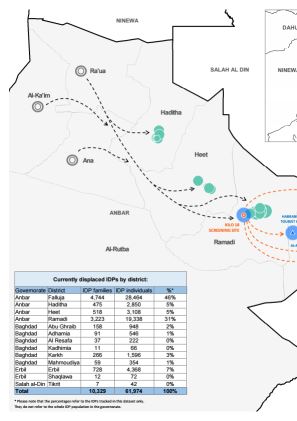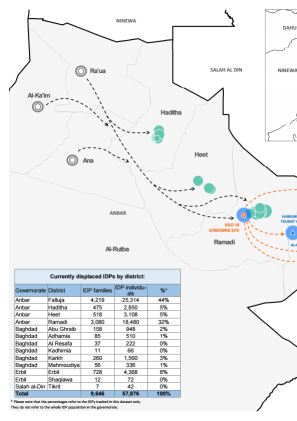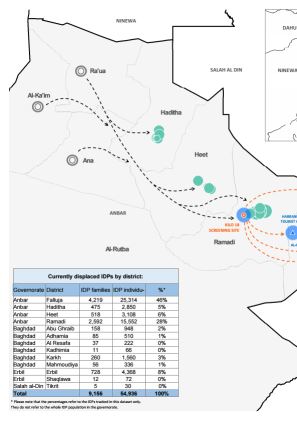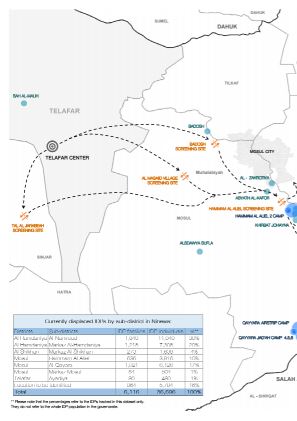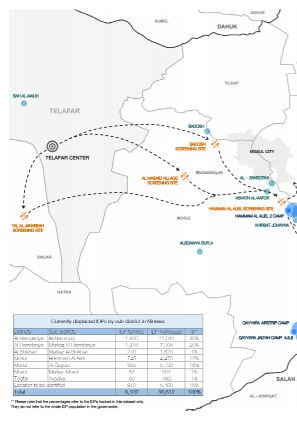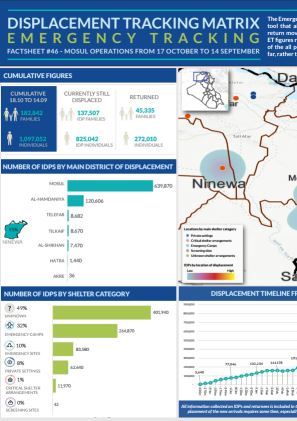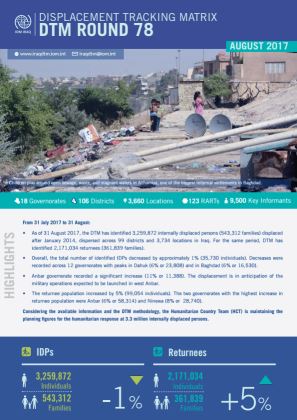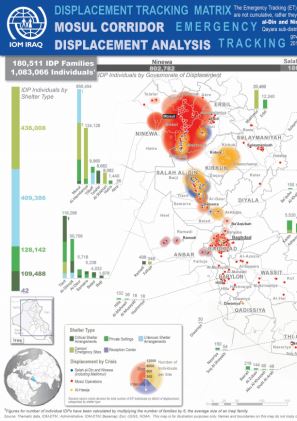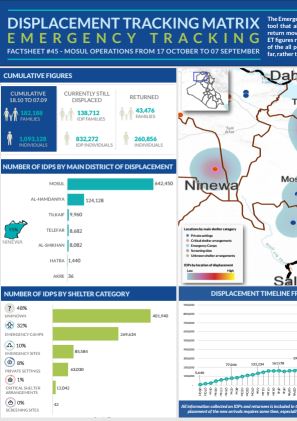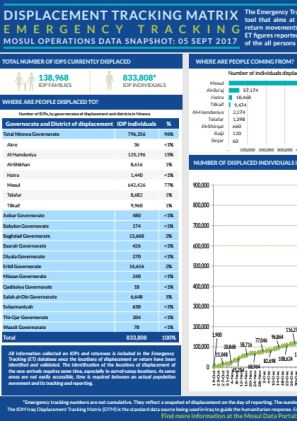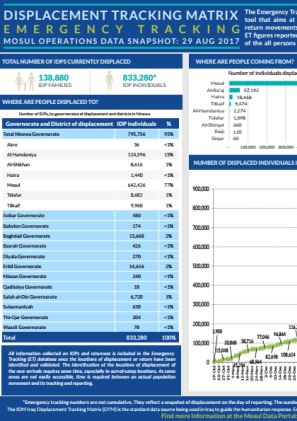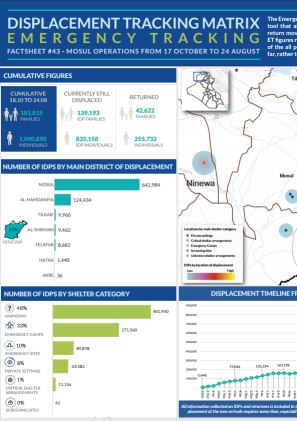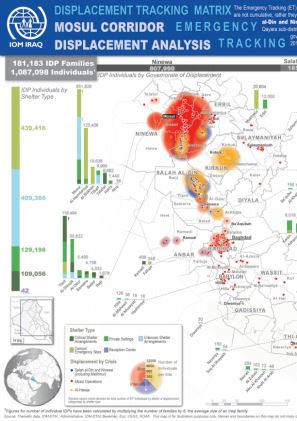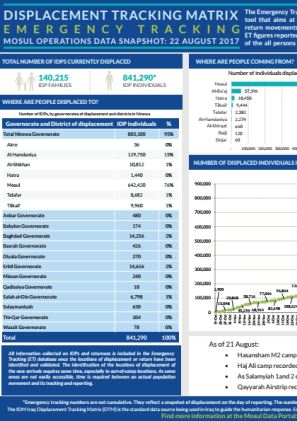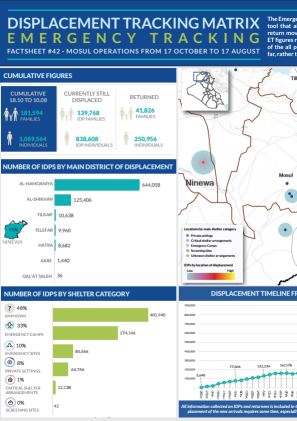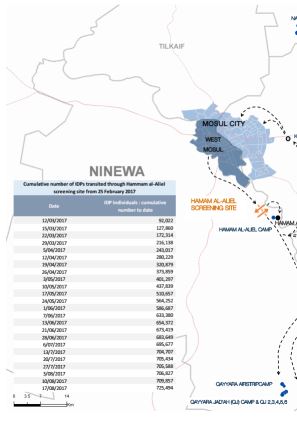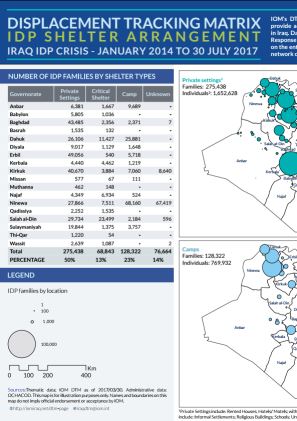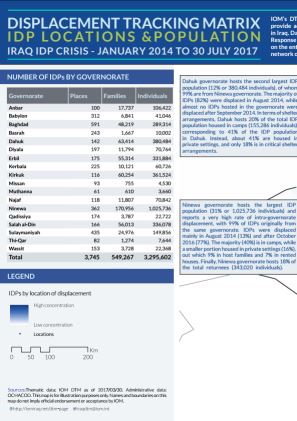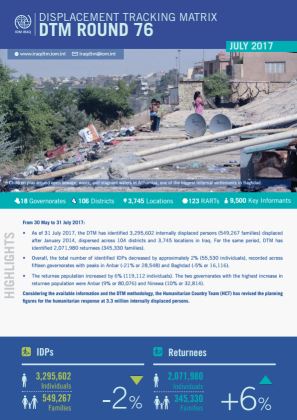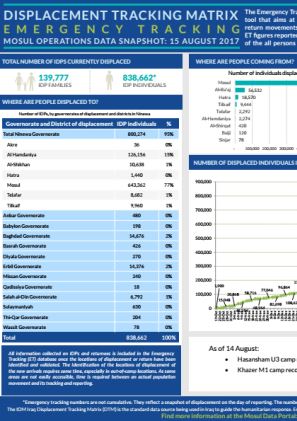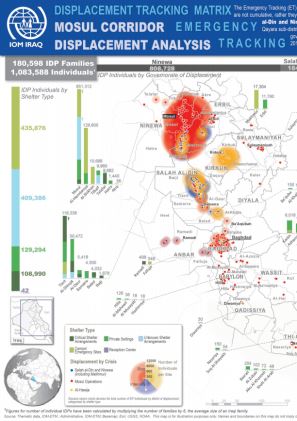-
Countries
-
Data and Analysis
-
Special Focus
-
Crisis Responses
Iraq
Suivi des PDI
Mouvements de déplacement
1,124,000
IDMC 2023
cycle de collecte de données
À propos Iraq
Reinforced in January 2014 in response to the need for information on displacement linked to the worsening armed conflict, the DTM programme in Iraq collects key information on internally displaced persons (IDPs) and returnees through different components and methodologies across the entire country.
Through IOM's Rapid Assessment and Response Teams (RARTs) -composed of 140 field staff- present throughout the Iraqi territory, the DTM collects data on numbers and locations of IDPs and returnees using an extended network of over 4,000 key informants. In addition to information collected from key informants, identified locations hosting IDPs are then visited and directly assessed by the RARTs to collect more detailed and in-depth information on the displaced population.
Please visit the Access to Durable Solutions among IDPs in Iraq
Iraq — West Anbar Crisis Displacement Overview (19 October 2017)
The DTM has been monitoring displacement movements from west Anbar areas, particularly the districts of Ana, Al-Ka’im and Ru’ua, since January 2017.
Iraq — West Anbar Crisis Displacement Overview (12 October 2017)
The DTM has been monitoring displacement movements from west Anbar areas, particularly the districts of Ana, Al-Ka’im and Ru’ua, since January 2017.
Iraq — West Anbar Crisis Displacement Overview (5 October 2017)
The DTM has been monitoring displacement movements from west Anbar areas, particularly the districts of Ana, Al-Ka’im and Ru’ua, since January 2017.
Iraq — Tel Afar Crisis Displacement Overview (24 September 2017)
On 20 August 2017 the military operations to retake Telafar and surrounding areas were launched.
Iraq — Tel Afar Crisis Displacement Overview (14 September 2017)
On 20 August 2017 the military operations to retake Telafar and surrounding areas were launched.
Iraq — Telafar Crisis Displacement Dashboard (9 July — 14 September 2017)
This overview highlights that 36,612 IDPs transited through Hammam Al Aliel screening site since 9 July 2017.
Iraq — Mosul Operations Emergency Tracking Factsheet 46 (14 September 2017)
During the reporting period, DTM identified a total of 182,842 IDP families comprised of 1,097,052 individuals who are currently still displaced. Tha main districts of displacement include Mosul with 639,870 IDPs and Al-Hamdaniya with 120,606 IDPs.
Iraq — Displacement Report 78 (August 2017)
As of 31 August 2017, the DTM has identified 3,259,872 internally displaced persons (543,312 families) displaced after January 2014, dispersed across 99 districts and 3,734 locations in Iraq.
Sep 13 2017
Iraq — Displacement Report 78 (August 2017)
Iraq — Mosul Operations Data Snapshot (12 September)
As of 12 September 2017, DTM identified 138,290 IDP families (827,740 individuals) currently still displaced. Of these, the majority originated in Mosul district (740,034 individuals).
Iraq — Emergency Tracking Mosul Corridor Displacement Analysis (10 September 2017)
This Emergency Tracking (ET) system tracks displacement along the Mosul Corridor as of 10 September 2017. The dashboard merges three ET datasets and records a total of 180,511 internally displaced families (1,083,066 individuals).
Iraq — Mosul Operations Emergency Tracking Factsheet 45 (7 September 2017)
During the reporting period, DTM identified a total of 182,188 IDP families comprised of 1,093,128 individuals who are currently still displaced. Tha main districts of displacement include Mosul with 642,450 IDPs and Al-Hamdaniya with 124,128 IDPs.
Iraq — Mosul Operations Data Snapshot (5 September 2017)
As of 5 September 2017, DTM identified 138,968 IDP families (833,808 individuals) currently still displaced. Of these, the majority originated in Mosul district (744,180 individuals).
Iraq — Emergency Tracking Mosul Corridor Displacement Analysis (28 August 2017)
This Emergency Tracking (ET) system tracks displacement along the Mosul Corridor as of 28 August 2017. The dashboard merges three ET datasets and records a total of 180,712 internally displaced families.
Iraq — Mosul Operations Data Snapshot (29 August 2017)
As of 29 August 2017, it was found that a total of 138,880 families or 833,280 individuals have been internally displaced, with a large majority (95%) being displaced to the Ninewa Governorate.
Iraq — Mosul Operations Emergency Tracking Factsheet 43 (24 August 2017)
From 18 October to 24 August 2017, a total of 181,815 IDP families (1,090,890 individuals) have been displaced as a result of the Mosul Operations.
Iraq — Emergency Tracking Mosul Corridor Displacement Analysis (21 August 2017)
This Emergency Tracking (ET) system tracks displacement along the Mosul Corridor as of 21 August 2017. The dashboard merges three ET datasets and records a total of 181,183 internally displaced families.
Iraq — Mosul Operations Data Snapshot (22 August 2017)
This Emergency Tracking (ET) system is a crisis-based tool aimed at tracking sudden displacement or return movements caused by the Mosul operations which started on 17 October 2016.
Iraq — Mosul Operations Emergency Tracking Factsheet 42 (17 August 2017)
DTM identified 139,768 IDP families (838,608 individuals) who are currently displaced and 41,826 returnee families (250,956 individuals). 48% of the displaced population is living in unknown shelter arrangements and 33% are living in emergency sites or camps.
Iraq — West Mosul Displacement Overview (17 August 2017)
The flow monitoring figures provide an indication of the cumulative number of IDPs displaced from west Mosul. They do not reflect the current number of IDPs from west Mosul who are still displaced, as some might have returned.
Iraq — IDP Shelter Arrangement (July 2017)
From the start of January 2014 through 30 July 2017, the DTM identified 3,295,602 internally displaced individuals (549,267 families). This maps shows the sizes of IDP population residing in three main shelter categories (private, critical, camp plus unknown).
Aug 16 2017
Iraq — IDP Shelter Arrangement (July 2017)
Iraq — IDP Locations and Populations (July 2017)
Ninewa governorate hosts the largest IDP population (31% or 1,025,736 individuals) and reports a very high rate of intra-governorate displacement, with 99% of IDPs originally from the same governorate.
Aug 16 2017
Iraq — IDP Locations and Populations (July 2017)
Iraq — Displacement Report 76 (July 2017)
As of 31 July 2017, the DTM has identified 3,295,602 internally displaced persons (549,267 families) displaced after January 2014, dispersed across 104 districts and 3,745 locations in Iraq. For the same period, DTM has identified 2,071,980 returnees (345,330 families).
Aug 16 2017
Iraq — Displacement Report 76 (July 2017)
Iraq — Mosul Operations Data Snapshot (15 August 2017)
DTM identified 139,777 IDP families comprised of 838,662 individuals. The majority of the identified individuals (748,932) originated from Mosul. As of 14 August, Hasansham U3 camp recorded an overall increase of approximately 133 IDP families.
Iraq — Emergency Tracking Mosul Corridor Displacement Analysis (14 August 2017)
As of 14 August 2017 DTM identified 180,598 IDP families (comprised of 1,083,588 individuals).
Pagination
Pagination
- First page
- Previous page
- …
- 5
- 6
- 7
- 8
- 9
- 10
- 11
- 12
- 13


